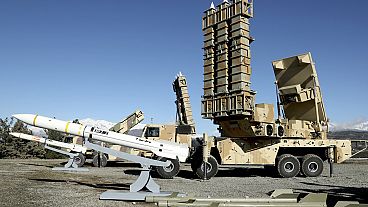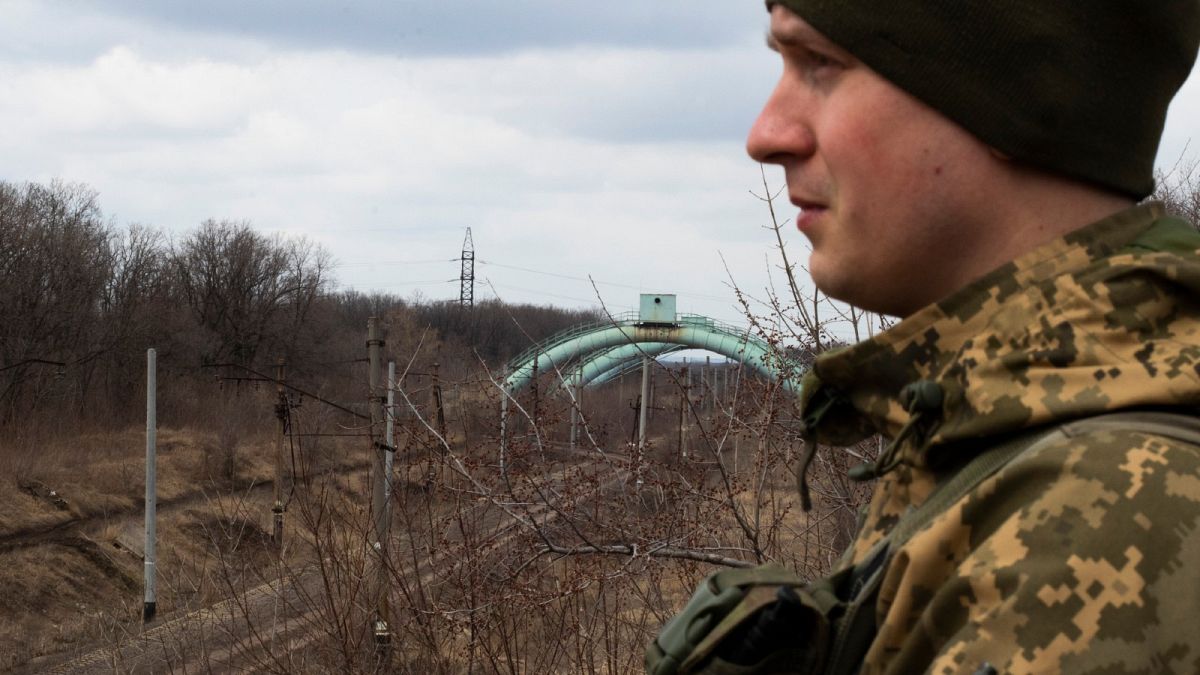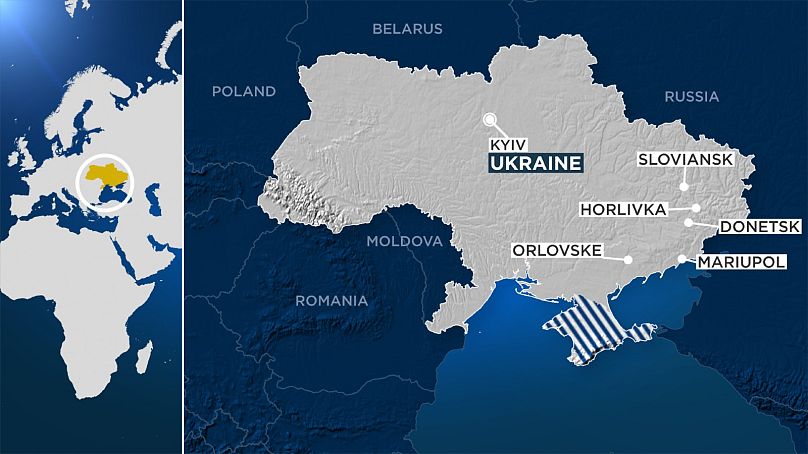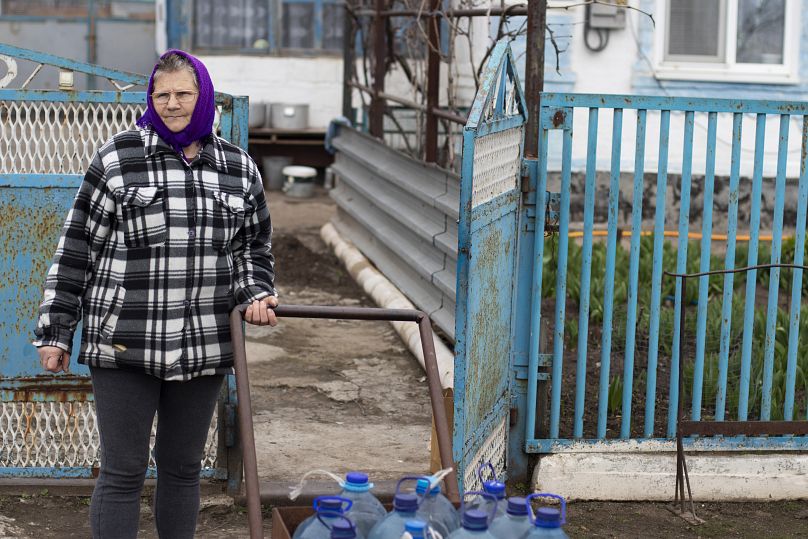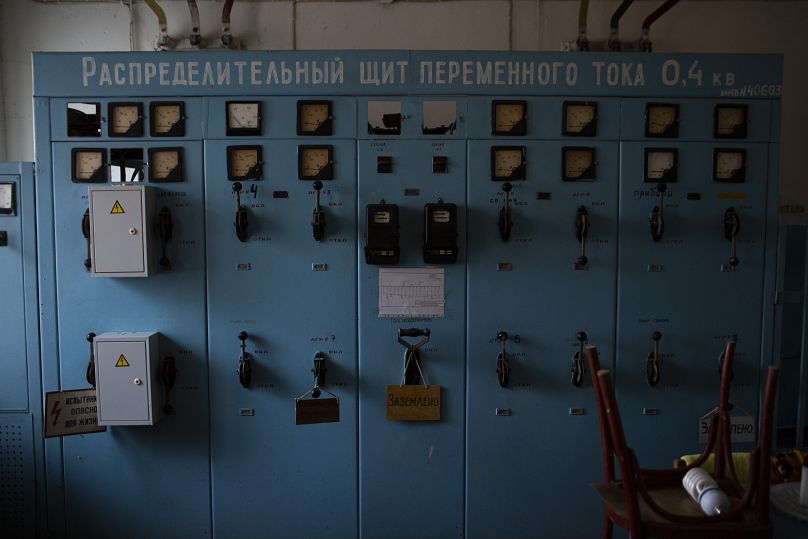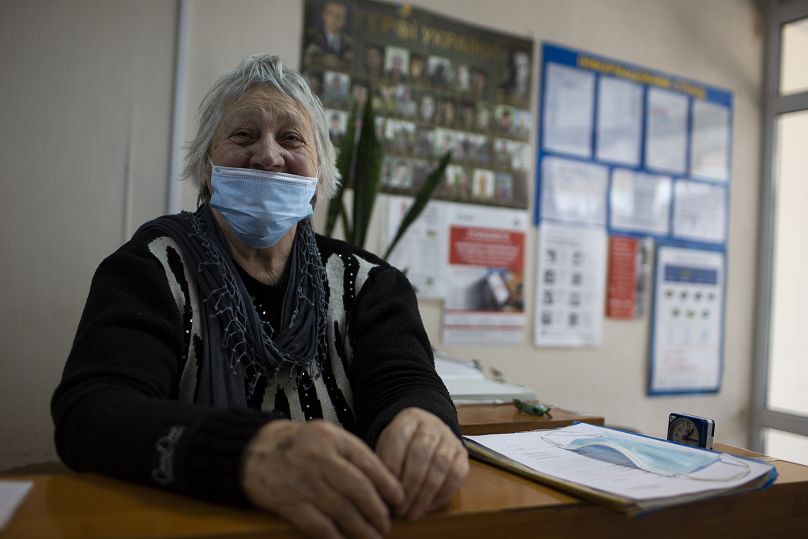As a consequence of the war, thousands of Ukrainians have no access to clean drinking water. They rely on NGOs for water deliverances, as the pipelines have been tangled up in the seemingly endless fighting on the eastern front.
A group of villagers sit in a little tent. It is chilly, so they are not there to enjoy the weather. They are not there to appreciate the view either: only a decrepit former Soviet palace of culture and a bumpy road are visible from the tent.
It is Saturday in the village of Orlovske and that means the water truck has been to the village with its weekly delivery of clean drinking water.
The locals argue quite a bit as water flows into plastic bottles through a hose. They know once the tank is empty, there will be no more clean water for another week.
The village is only seven kilometres from the frontline in eastern Ukraine, where Kyiv and Russian-backed separatists have been fighting a war since 2014. An estimated 13,000 have been killed.
Orlovske is, like many other villages, isolated. It is not connected to the gas or water pipes due to the collateral damage of war and lack of investment.
A lack of repairs means the village is only connected to the closest big city, Mariupol, by one dangerous road along the frontline.
“Every day, we can hear the shelling,” one of the villagers told Euronews about the recent escalation of the war, “We can feel the shockwaves in our houses. We hear rumours of the second wave of the war. Everything is horrifying right now.”
Orlovske has a borehole where villagers can pump out water, but it is not clean enough for drinking. However, the villagers sometimes resort to drinking it either way when they run out of clean water. There are plenty of villages like Orlovske along the line of contact. Still, even bigger cities struggle with the water supply as well, meaning that thousands of Ukrainians are dependent on NGOs delivering water much the same way as in Orlovske.
Water workers 'are regularly attacked'
There are around 12,000 kilometres of pipes near the frontline in eastern Ukraine, supplying water to about 3.8 million people from Sloviansk in the north to Mariupol in the south, 270 kilometres away.
Some villages like Orlovske are disconnected from that water system, but the war makes the water supply problematic for all cities near the frontline.
The pipes come from the north of Ukraine and twist back and forth across the frontline between territory controlled by Russian-backed separatists and the Ukrainian government, making both sides dependent on each other.
If a significant pipeline breaks down or is attacked, everyone south of that point will be left without water. It includes large cities such as Donetsk (controlled by the separatists) with around one million people, Horlivka (also controlled by the separatists) with about 600,000 people, and Mariupol 430,000 people.
“The situation here is very unique," Sebastien Truffaut, head of water, sanitation and hygiene at UNICEF Ukraine, which works to secure a clean water supply on both sides of the frontline, told Euronews.
"The large cities are concentrated around areas with a lot of coal but little water, making them dependent on water from far away.
"It is awful in a region at war.”
The water system often breaks down as most pipes and equipment are from the 1950s and 1960s, and fighting on both sides of the frontline makes it hard to do repairs, explained Truffaut.
UNICEF estimates that 60 per cent of all pipes will have to be replaced, but that is often difficult in a warzone where investors are reluctant to plough money in.
The amount of water running through these pipes is around 2.5 times what is supplied to Paris.
“This is two highly skilled armies standing in front of each other. Water infrastructure and water workers are regularly subject to attacks, which affects the water supply to the region and deprives the population of their right to water,” says Truffaut, and points out that nine water workers have died in the war.
“There are areas that we can hardly get access to, and that means that we have a constant water leakage,” he said, expressing concern about recent developments in eastern Ukraine, where fighting between the two sides has escalated in recent months.
A new ceasefire back in July last year reduced fighting dramatically and improved the water supply. However, recently, it has intensified again, threatening the regions’ water supply once again.
Truffaut told Euronews that UNICEF registered 136 attacks on water facilities and water infrastructure in 2017, 98 in 2018, 88 in 2019, and 61 in 2020, with hardly anything after the ceasefire last July. There have been four incidents in 2021 so far.
“The active conflict also makes it hard to get access to certain areas,” said Truffaut, explaining that water workers need clearance from both sides to work near the frontline safely, but that it is not a guarantee that they will not be shot at. On top of this, there is the risk of landmines.
'We are afraid to do repairs'
Two water companies are working in the region. One, named Water of Donbas, has workers on both sides of the frontline and runs several filter stations to secure clean water along one main pipeline from Sloviansk to Mariupol.
Maxim works for the company in the city of Chasiv Yar, near the frontline, and leads a team doing repairs. He told Euronews he has experienced several dangerous situations with shootings and even a mine explosion while working near the combat zone. It's a situation that makes him and his colleagues reluctant to do such work.
“OSCE (the Organization for Security and Co-operation in Europe) secures the area before my team goes in,” said Maxim, “But we still do not feel safe. We can never be safe when we go in. We felt safe before 2018, but the situation now is more unstable for us.”
Maxim shows Euronews around at the water station in Chasiv Yar, where service trucks stand next to sections of water pipes, ready to be used. He points to an old crane truck with resemblance to an army truck parked outside. He said this is the ideal equipment to fix broken pipes but that they cannot use such crane trucks near the frontline, as it might be mistaken with a military truck. Instead, they are forced to use smaller less powerful equipment.
“This is an old EO 3322 crane,” said Maxim, “It is the one that we have to use near the frontline. It is currently being repaired, and we cannot do everything with it. It needs repairs after every job and is very unreliable. It is 32 years old and drives five kilometres per hour.”
The head of the mechanical department at the facility is named Sergei, and he told Euronews that it is getting more and more difficult to get spare parts for such old equipment. It means that it is only “a matter of time before this crane will not be working anymore”.
Anatolii Sergeevich is the department director in Chasiv Yar and leads 22 water locations across both sides of the frontline. In his office, he told Euronews that he just got a report from a filter station inside the separatists’ area. They claim that the Ukrainian military was shooting at them last night.
“There are more and more shootings now. I get a status report every day, and we see an increase from both sides,” Sergeevich said. “But we also have problems with the very old pipes, often 50 to 60 years old. Thirty kilometres of pipes need to be fixed in my area, and we don’t have the resources to do that.”
'A lot of things need to change'
UNICEF estimated in 2019 that a total of $170 million is needed to do the most urgent repairs.
Sergeevich says that his department has around 1.2 million hryvnias -- about €36,000 -- a year for doing repairs and that if it weren’t for international organisations such as UNICEF, “it would be very difficult for people to get any water at all”.
At another filter station, Eduard, heading the production department at Water of Donbas in Chasiv Yar, said that hardly anything has changed since 1958 and that the last repair was done here around 20 years ago. Only a chemical mixing room, financed by UNICEF, is modern and stands in sharp contrast to the filter station’s general condition.
According to a 2019 report from UNICEF, the water supply’s main problems are related to war and the age of the equipment, and the lack of finances and willingness to support the water sector. A large number of industries in the Donbas region constitutes a permanent risk of pollution of rivers and thus of the water supply.
“The war makes it very hard to make lasting solutions,” said Truffaut. “The water companies are in huge debt to electrical service providers. There are also problems with the bureaucracy on both sides, where the separatists, for example, are very suspicious and only give us the minimal information needed to operate. While this is going on, the water supply and people’s access to clean water is at risk.
“There is a real need for conflict resolution, commitment from the central administration, and financial investments to improve the situation,” he added.
'Please, don’t stop the water'
UNICEF and other donors’ resources are, however, limited. One of UNICEF's partners, ADRA, provides clean drinking water at several locations in the city of Avdiivka near the frontline, but the programme will soon be shut down due to a lack of funds, ADRA said. Many locals are frustrated as they rely on these water depots for clean drinking water.
“Please, please. Do not stop sending the water,” 85-year-old Inna Shlyakhova, a local resident in Avdiivka, told Euronews, afraid we are here to shoot the project down.
Since 2014, ADRA has delivered 2.5 million litres of clean drinking water to Avdiivka.
“We need this water. The water at home is often dark, brown, or some other colour. We try to filter and boil the tap water, but it is not very good,” she said. “My washing machine is full of dirt, and it is scary to do dishes. I worry about what happens to us when we drink the water from the tap.
“I have seen many bad things in my life, but I fear that everything will get much worse now if they (ADRA) will stop coming with water and the war will break out again.”
Every weekday at 1900 CEST, Uncovering Europe brings you a European story that goes beyond the headlines. Download the Euronews app to get an alert for this and other breaking news. It's available on Apple and Android devices.
